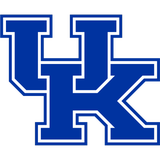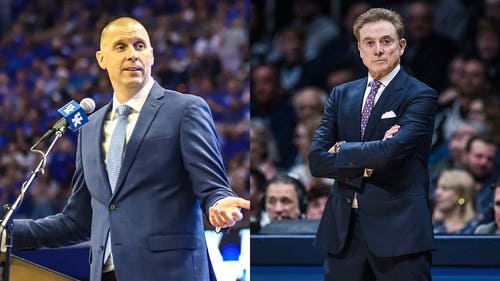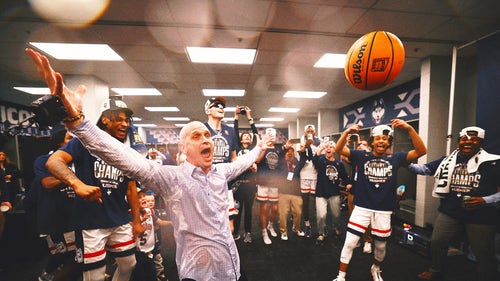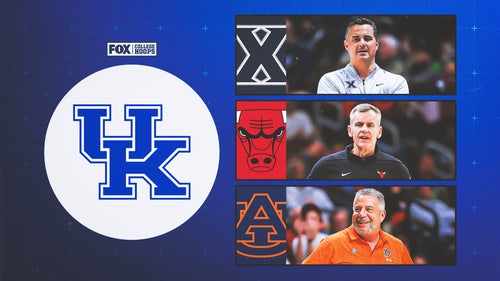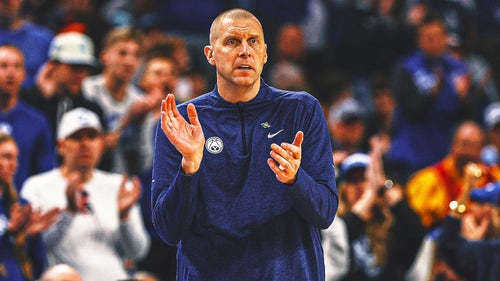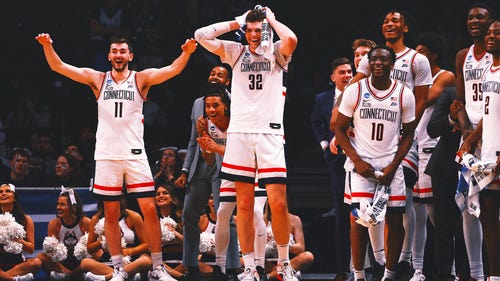
Blowing up your NCAA Tournament bracket conspiracy theories
On Sunday night, the selection committee will unveil its bracket, and basketball fans will immediately begin proffering their conspiracy theories.
The committee hates Michigan so they shipped them to Sacramento.
The committee hates Calipari so they gave Kentucky the hardest region.
The committee loves Coach K so they gave Duke the easiest bracket.
For every one of these, there’s usually a more logical explanation, based largely on the many rules dictated by the NCAA’s published Principles and Procedures for bracketing.
To give you a better sense how that process works (which I learned myself by participating in the NCAA’s mock selection seminar), I’m going to take you step-by-step through how I slotted the top 16 teams in my latest bracket.

Mike Krzyzewski
To start, here’s the top 16 on my true seed list as of Wednesday morning. (How I came up with said order is a subject for another column.)
And now, here are the key rules to remember as we go through this exercise:
— Teams are placed in their closest available geographic region, with the top team on each seed line getting first preference, followed by each team thereafter.
— Teams on the top four seed lines also get placed in the closest geographic pod the first weekend if possible.
— The top four teams from each conference will be placed in different regions if they’re seeded on the first four lines.
— Once all 16 teams are placed, the committee adds up the true seeds in each region to ensure they are fairly balanced. “Generally, no more than five points should separate the lowest and highest total.”

Frank Mason
No. 1 seeds (in order): Kansas, Villanova, North Carolina and Gonzaga
This part’s pretty simple. Kansas goes to the Midwest (Kansas City) and gets the Tulsa pod.
Villanova stays in the East (New York) and starts in Buffalo.
UNC gets the South (Memphis) and the Greenville, S.C., pod.
Gonzaga tops the West (San Jose) and begins in Salt Lake City.
Rarely does it work out this way that all four teams go to their preferred region. For example, last year, No. 3 overall seed Virginia got moved to the Midwest (Chicago) because No. 2 overall seed North Carolina beat out the Cavaliers for top seed in the East (Philadelphia).
The placement of the No. 1 seeds also dictates where the four regions fall on the bracket. The Midwest, what with the overall No. 1 seed, will fall on the same side as the West, which has the No. 4 overall seed. The other side becomes East (No. 2) vs. South (No. 3).

Rick Pitino
No. 2 seeds: Oregon, UCLA, Baylor, Louisville
Oregon is the obvious choice for the No. 2 seed in the West opposite Gonzaga. It gets the Sacramento pod. And now, those principles and procedures start kicking in.
With the No. 2 seed in the West already claimed, UCLA moves to the South (and Sacramento).
Up next, Baylor’s natural region would be the Midwest, but it can’t go because the Big 12’s Kansas is already there. Baylor instead goes to the East and joins the Jayhawks in the Tulsa pod.
Finally, Louisville’s closest regional site is Memphis, but all that’s left is the Midwest. The Cardinals start in Indianapolis.
Here’s where we stand so far (true seeds in parentheses):
| East | South |
| 1. Villanova (2) | 1. North Carolina (3) |
| 2. Baylor (7) | 2. UCLA (6) |
| Midwest | West |
| 1. Kansas (1) | 1. Gonzaga (4) |
| 2. Louisville (8) | 2. Oregon (5) |
No. 3 seeds: Kentucky, Florida State, Butler, Arizona
Kentucky, the first team from the SEC, gets placed in the South and joins Louisville in Indianapolis. (Good luck finding tickets to that pod.)
Florida State is slightly closer to Kansas City (1,044 miles) than New York (1,091), but there’s already an ACC team in the Midwest, so the ‘Noles go to the East (and start in Orlando).
Here’s where things get interesting. Butler would obviously prefer the Midwest to the West, but Arizona, the team ranked right behind the Bulldogs, can’t be placed in the same region as Oregon. So there’s no avoiding Arizona getting shipped to the Midwest and Butler to the West.
Perhaps more disappointing for Butler, Kentucky and Louisville beat out the Bulldogs for the Indianapolis pod. Fortunately for Butler fans, Milwaukee is still within driving distance. Arizona should be happy with Salt Lake City.
Now we’ve got our first three lines.
| East | South | ||
| 1. Villanova (2) | Buffalo | 1. North Carolina (3) | Greenville |
| 2. Baylor (7) | Tulsa | 2. UCLA (6) | Sacramento |
| 3. Florida State (10) | Orlando | 3. Kentucky (9) | Indianapolis |
| Midwest | West | ||
| 1. Kansas (1) | Tulsa | 1. Gonzaga (4) | Salt Lake City |
| 2. Louisville (8) | Indianapolis | 2. Oregon (5) | Sacramento |
| 3. Arizona (12) | Salt Lake City | 3. Butler (11) | Milwaukee |
I can already see people drooling over and/or complaining about the “loaded” South region.
No. 4 seeds: Duke, Purdue, Florida, West Virginia
Despite being first on this seed line, Duke has only one region available to it — the West. That’s because it’s the fourth ACC team in the field, and the first three claimed the three closer regions. There goes that conspiracy theory. The Blue Devils join rival North Carolina in the Greenville pod.
Purdue as the first Big Ten team gets to stay in the Midwest. The Indianapolis pod is full, so the Boilers join fellow Hoosier State school Butler in Milwaukee.
Florida can’t go to the South because Kentucky is already there, so the Gators get the East. (Potential Florida-Florida State Elite 8 game, anyone?) UF also gets to play in Orlando the first week.
West Virginia would have loved to stay in the East but can only go to the South. It joins Villanova in the Buffalo pod. You know we lucked out a little bit with the distribution of the pods when even the No. 15 and 16 teams got their top choices.
And now, the full top four seed lines:
| East | South | ||
| 1. Villanova (2) | Buffalo | 1. North Carolina (3) | Greenville |
| 2. Baylor (7) | Tulsa | 2. UCLA (6) | Sacramento |
| 3. Florida State (10) | Orlando | 3. Kentucky (9) | Indianapolis |
| 4. Florida (15) | Orlando | 4. West Virginia (16) | Buffalo |
| Midwest | West | ||
| 1. Kansas (1) | Tulsa | 1. Gonzaga (4) | Salt Lake City |
| 2. Louisville (8) | Indianapolis | 2. Oregon (5) | Sacramento |
| 3. Arizona (12) | Salt Lake City | 3. Butler (11) | Milwaukee |
| 4. Purdue (14) | Milwaukee | 4. Duke (13) | Greenville |
As I wrote earlier, the goal is to keep the total seed numbers for each region within five points of each other. The tallies here: Midwest 35, East and South 34, West 33. That’s almost ideally balanced.
The rest of the field gets placed exactly the same way as the top four lines, though pods are no longer a factor. A No. 11 seed gets placed at the same site as the Nos. 3, 6 and 14 seeds in its region. A No. 12 is tied to the Nos. 4, 5 and 13.
But the deeper you get into the field, the harder it becomes to avoid teams from the same conference playing earlier than allowed. If teams played three times during the season, they can’t meet before the Elite Eight; if they played twice, then not before the Sweet 16; if once, then not until the second round.
Case in point, Seton Hall as my top No. 9 seed (No. 33 overall) would normally get first dibs on the East, but that would create a potential second-round matchup with Villanova, which it’s already played twice. Can’t happen.
You also have to avoid regular-season rematches in the first round. In this bracket, that precluded No. 6 seed Minnesota vs. No. 11 seed Vanderbilt (they met Dec. 3) or No. 3 seed Florida State vs. No. 14 seed Winthrop (Nov. 18).
So now, knowing all of that, hopefully you have a better understanding of the process. And hopefully you’ll now believe me when I say it’s hard enough to produce a bracket that complies with all those rules without trying to manipulate the matchups.
Now imagine the committee trying to do the same with only a couple of hours to spare on Selection Sunday.
